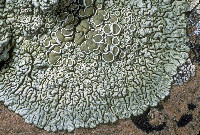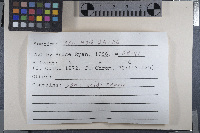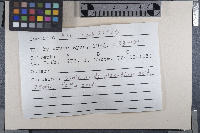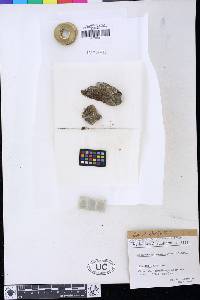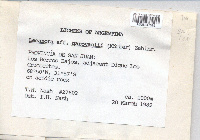
Consortium of Lichen Herbaria
- building a Global Consortium of Bryophytes and Lichens as keystones of cryptobiotic communities -
- Home
- Search
- Images
- Species Checklists
- US States: O-Z >
- US National Parks
- Central America
- South America
- US National Parks
- Southern Subpolar Region
|
|
|
|
Family: Lecanoraceae
[Lecanora garovaglii (Körb.) Zahlbr., moreLecanora garovaglii f. garovaglii (Körb.) Zahlbr., Lecanora garovaglii subsp. cascadensis (H. Magn.) B.D. Ryan & T.H. Nash, Lecanora garovaglii subsp. garovaglii (Körb.) Zahlbr., Lecanora nevadensis H. Magn.] |
Nash, T.H., Ryan, B.D., Gries, C., Bungartz, F., (eds.) 2004. Lichen Flora of the Greater Sonoran Desert Region. Vol 2. Thallus: placodioid, 4-6 cm or more in diam., 0.5-2(-3) mm thick in center, distinctly rosetted, but often confluent, tightly to usually +loosely adherent; rimose-areolate to verrucose-areolate or bullate-areolate in center; prothallus: vestigial, the lobe tips and occasionally edges frequently dark olivaceous to bluish black areoles: contiguous, irregular in outline, 0.3-1.5 mm across, convex to irregularly depressed lobes: 4-8 mm long, 0.5-1.5 mm wide, to c. 1 mm thick, +contiguous, usually +distinct to the thallus center, plane to +strongly but irregularly convex and swollen, sinuous, weakly to strongly plicate, furrowed along the center, or irregularly foveolate, crenate-incised towards tips, the ultimate segments 0.3-0.7 mm wide; tips dilated, often recurved upper surface: +dull, spottily to densely pruinose; continuous to rather strongly rimose; pale, moderate, or grayish greenish yellow, pale or grayish yellowish green, light to moderate or grayish yellow, in herbarium pale yellow, pale brown or olivaceous; towards lobe tips often yellower, sometimes +irregularly maculate, esorediate upper cortex: without dead algal cells, 15-50 µm thick; inspersed with yellowish granules (soluble in K); hyphae: conglutinate, +anticlinal, fastigiate, 2-3(-4) µm wide, epinecral layer: present or absent medulla: white, or darkening towards lower side, very loose, arachnoid, becoming hollow in center; hyphae: 2-3(-6) µm, +covered with granules (insoluble in K); algal layer: weakly to +strongly divided by narrow hyphal bundles, often extending downward to lower side at edges and tips lower surface: pale gray and arachnoid, or towards edges and tips smooth and strong to dark grayish to yellowish brown or green to black lower cortex: 8-18 µm thick, +continuous; hyphae: periclinal, the cells rounded-angular, 2-7 µm in diam., Apothecia: scattered, to crowded towards thallus center, borne submarginally up to 5 per areole, constricted sessile, 0.7-2 mm in diam. disc: pale to moderate yellow, orange- or red- brown, white when wet (due to heavily inspersed hymenium) or (ssp. cascadensis) becoming dark grayish to yellowish brown to olivaceous to blue-black or in shade, light to moderate yellow, +plane, dull, epruinose margin: pale yellow to brown, 0.1-0.2 mm wide, becoming radially cracked, finally excluded, strongly pruinose, with a conspicuous, well-delimited (especially on young apothecia) parathecial ring amphithecium: present, with a +densely packed, +strongly interrupted algal layer (30100 µm thick) in the margin and extending below the hypothecium, with white granules (insoluble in K) in the medulla, corticate; cortex: distinct, 35-50(-75) µm thick, similar to that of thallus parathecium: hyaline, 15-25 µm thick, with +periclinal hyphae epihymenium: pale orange to dark brown, inspersed with fine granules (soluble in K, insoluble in N) or (spp. cascadensis) inspersed with small granules (dissolving in K, no reaction with N), but in blackish discs greenish brown, or not inspersed. 10-25 µm thick hymenium: hyaline, 50-65 µm tall; paraphyses: conglutinated; tips: clavate, 2-3 mm wide, hyaline (N-), or (ssp. cascadensis) capitate, 4-5 µm wide and olive-green to greenish black (K+ green, N+ reddish to red-violet); subhymenium: hyaline to pale gray, 20-40 µm thick; hypothecium: rather shallowly bowl-shaped, (10-)75100 µm thick; hyphae: randomly oriented to anticlinal in bundles, 3-7 µm wide asci: narrowly clavate, 8-spored ascospores: hyaline, simple, ellipsoid to broadly ellipsoid or ovoid-globose, 8-12 x 5-6(-7) µm Pycnidia: immersed; ostioles: dark; conidiophores: type III of Vobis (1980) conidia: filiform, (20-)25-35 µm long Spot tests: thallus K-or + pale yellow in places, C-, KC-, P-; upper cortex KC+ yellow, the blackened parts N+ red-violet; medulla usually K-, KC- Secondary metabolites: cortex with usnic acid, +placodiolic or isousnic acids or both; medulla usually with zeorin and unidentified terpenoids (without leucotylin), and occasionally various phenolic substances. Nash, T.H., Ryan, B.D., Gries, C., Bungartz, F., (eds.) 2004. Lichen Flora of the Greater Sonoran Desert Region. Vol 2. Substrate and ecology: on the same types of rock as ssp. garovaglii; in desert to montane areas dominated by vegetation similar to that for ssp. garovaglii, but absent from cooler and moister areas with pines or firs World distribution: western North America and South America Sonoran distribution: common in northern and central Arizona, 910-2440 m, occasional in southern California, 670-913 m and Baja California and Baja California Sur, 780-1300 m Notes: Lecanora garovaglii subsp. cascadensis differs from the typical subspecies mainly in having yellowish black to blue-black (N+ red) discs (however, in our region, where both subspecies occur primarily in shaded habitats, the discs of both tend to be pale yellow, N-, but sometimes partly blackened by parasites and then N+ reddish). The various differences in thallus anatomy and spore sizes among L. cascadensis, L. nevadensis, and L. garovaglii that were noted by Magnusson (1933, 1940) do not appear to be consistent or useful. Although in practice the two subspecies of L. garovaglii are sometimes very difficult to distinguish from each other (especially without a N test), they do have somewhat different distributions (complete absence of subsp. cascadensis in Eurasia and Africa, and in North America with ssp. cascadensis primarily in the Cascades, Sierra Nevada, and Great Basin, vs. the typical variety apparently restricted to the Rocky Mountains and their foothills, with extensions into northwestern Mexico) helps to justify treating cascadensis as a subspecies. The same set of chemotypes, at least as far as cortical chemistry goes, occur in both subspecies, but in our region, isousnic acid is essentially restricted to ssp. cascadensis. |
|
|
|
Powered by Symbiota



